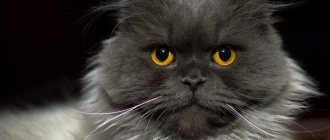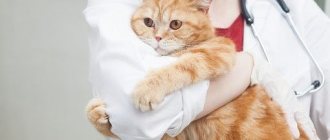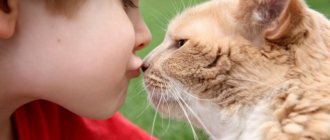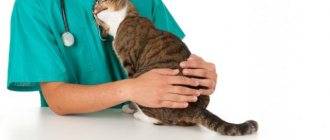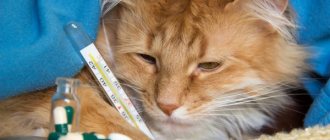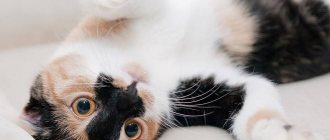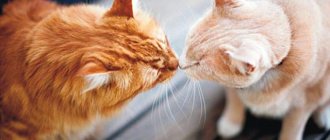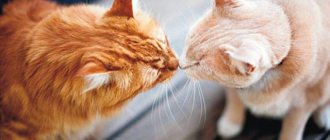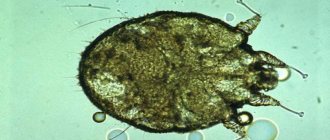Despite its modest size, a small lump in the anal area can significantly ruin the life of a pet. Prolapse of hemorrhoids occurs due to a shift in the center of gravity to the pelvic area. People who lead a sedentary lifestyle often suffer from this problem.
Unlike humans, domestic animals move not on two, but on four limbs. Their center of gravity is in the chest area. Owners who know this don’t even think about whether their cat might have hemorrhoids, because they are sure that this is impossible. Despite the logical justification, this opinion is erroneous.
Do male cats get hemorrhoids?
Dilation of the veins in the rectum in mustachioed pets is a rare, but still common phenomenon. Inflammation caused by impaired blood flow leads to deformation of blood vessels. They intertwine into knots and fall out of the anus, causing unpleasant and painful sensations during emptying.
If you suspect that your cat has hemorrhoids, check with your veterinarian about what to do. Despite the similarity of the main symptoms of the disease, the treatment of mustachioed pets and humans is very different.
What symptoms will indicate the disease?
With this pathology, the animal may meow when sitting in the tray.
Hemorrhoids can occur in either a kitten or an old cat. In this case, the symptoms are practically no different from the manifestations of the disease in humans. The symptoms are quite easy to identify; the owner of the animal can only carefully observe the behavior and changes in the cat’s condition. The first sign that indicates the development of this pathology is a change in the pet’s gait. The animal may begin to spread its hind legs, defecate less frequently, and meow while on the tray.
At the initial stages of development, a compaction occurs, when palpated, you can detect a hard ball inside. As the disease progresses, this nodule begins to increase in size and extends beyond the sphincter. If the required therapy is not carried out during this period, the lump grows greatly and an ulcer may appear, from which blood systematically bleeds during emptying. In addition, the following symptoms of pathology are distinguished:
- redness near the anus;
- swelling;
- presence of hemorrhoids;
- prolonged constipation;
- blood in the stool;
- cat anxiety.
Causes of the disease
The main cause of feline hemorrhoids is blood stagnation, which reduces the tone of the blood vessels. This dangerous violation occurs under the following factors:
- advanced form of worm infection;
- cancerous tumors in the intestines;
- excess weight, fraught with the growth of cholesterol plaques;
- diseases of the urinary system (cystitis, urolithiasis);
- excessive or low physical activity;
- too short breaks between matings in breeding animals (with frequent pregnancies, the pressure in the pelvis remains at a dangerously high level);
- intestinal obstruction and frequent constipation;
- dehydration and poor nutrition (low amount of vitamins and lack of balance of KBJU);
- hormonal imbalances.
If your pet eats economy-class food, is neutered or is prone to obesity (Sphinxes, Persians, British), then he is at risk. A predisposition to pathology is inherited, so when buying a kitten, be sure to check all the diseases that its parents have encountered.
Prevention of hemorrhoids
Preventive measures should be carried out both by people with risk factors for the development of hemorrhoids, and by those who have already begun treatment for this disease:
- physical activity: walking, fitness programs without straining, swimming, exercise therapy;
- compliance with the work and rest schedule, for example, organizing food points on the highway for drivers, “physical education” for office employees, sometimes even a temporary change of job;
- compliance with the principles of ergonomics of the work process and labor protection rules;
- a diet that includes a sufficient amount of liquid and plant fiber;
- prevention and treatment of constipation;
- careful hygiene of the anus and perineum.
In this way, it is possible to prevent exacerbation and aggravation of the severity of the disease.
Symptoms of pathology
Symptoms of hemorrhoids in cats develop progressively. You can notice a disorder at an early stage only by behavioral changes, so it is very important not to ignore your pet’s mood changes.
Signs at different stages
A sick pet becomes nervous and restless. He loses his usual activity and appetite, devoting most of his time to anal hygiene.
More obvious signs develop in 3 stages:
- The hemorrhoid is located inside. It cannot be detected visually, but can be felt. The small compaction takes on a spherical shape.
- The node, swollen with blood, gradually falls out. The round shape changes to a cone shape.
- Under pressure, the vessels become thinner, so during defecation they are injured and bleed. At the site of the bump, a small bleeding ulcer appears, gradually increasing in size.
The resulting pain affects gait and bowel movements. When moving, the animal spreads its hind legs wide, trying not to touch the deformed veins. There is stool retention, drying of stool, and the appearance of mucous and bright scarlet discharge.
If your pet meows pitifully in the toilet, and its anus is red and swollen, sign up for an examination at the veterinary clinic. Otherwise, an infection may get into the open wound, aggravating the patient’s condition and complicating further treatment.
Similar diseases
Prolapse of hemorrhoids is a fairly rare pathology, so do not rush to look for a cure before making a diagnosis. Most often, the cause of the disorder is other diseases with similar symptoms:
- neoplasms and hernia in the intestine, as well as rectal prolapse, characteristic of animals with weak sphincter muscles;
- inflammation of the paraanal glands - small sacs with odorous secretions located immediately behind the entrance to the anus;
- helminthic infestation, accompanied by frequent licking due to itching;
- anal fissure, that is, spontaneous damage to the mucosa;
- ulcerative colitis, or inflammation of the large intestine.
Despite the similarity of symptoms, all of these diseases have different treatment regimens. For this reason, you should not draw conclusions until your pet is fully examined.
What is hemorrhoids confused with?
Inflammation of the glands of the paraanal area - in the anal area there are 2 anal glands, which are the source of secretion for marking the territory and for antiseptic action after defecation. When the excretory ducts are blocked, abscesses form, which can rupture and cause bleeding. The main treatment consists of removing pus from the ducts.
Rectal prolapse - occurs when the anal sphincter muscles fail, during difficult childbirth in a cat and frequent diarrhea. In appearance, the prolapsed intestine resembles an oblong cylinder of bright scarlet or bluish-burgundy color, which swells rapidly from compression by the sphincter muscles. This pathology requires mandatory surgical treatment and immediate contact with a veterinary clinic.
Why is it so important to visit a veterinarian?
An examination by a veterinarian ensures a correct diagnosis. After conducting all the necessary research, he will explain how to treat hemorrhoids in a kitten or adult animal and select safe dosages of medications.
In addition to confirming a specific violation, it is important to determine its cause. This will help get rid of the existing problem and prevent its occurrence in the future.
Diagnosis of hemorrhoids
Diagnosis begins with collecting anamnesis, clarifying complaints and examination by a proctologist.
The patient is positioned in a gynecological chair with his legs adducted, knee-elbow position, and less often - on his side. A physical examination by a proctologist includes:
- digital examination of the rectum;
- anoscopy (to examine the walls of the anal canal and distal rectum);
- sphincterometry (for chronic hemorrhoids - weakness, and for acute hemorrhoids - sphincter spasm);
- colonoscopy (for differential diagnosis);
- sigmoidoscopy (diagnosis of concomitant diseases of the colon);
- X-ray of the large intestine with barium (enema).
Endoscopic examinations are performed under anesthesia, in some cases under general anesthesia.
How to treat hemorrhoids in cats and kittens at different stages
Treatment for hemorrhoids in cats depends on its stage. At the initial stage, drug therapy is sufficient for recovery, but at a later stage, surgery cannot be avoided.
Light form
A mild form can be treated at home by reviewing the diet, proper hygienic care for the inflamed anus, and medications prescribed by a doctor. Depending on the condition, a mustachioed patient may be prescribed the following medications:
- anti-inflammatory and antibacterial ointments;
- venotonics, normalizing blood flow and restoring the integrity of damaged vessels;
- hemostatic suppositories and painkillers;
- laxatives that soften too hard and dry stools.
Among folk remedies, it is recommended to use sea buckthorn oil and yarrow infusion, which reduce inflammation. Before use, be sure to consult a veterinarian so as not to make a mistake in the dosage.
Launched form
Large ulcerations accompanied by severe bleeding must be removed. The operation is carried out using:
- cryosurgery, that is, freezing with liquid nitrogen;
- classical excision of dilated veins with a scalpel.
The first method is less invasive (with a minimum of intervention) and does not require the use of general anesthesia. After waking up, the mustachioed patient is returned to the owner, not forgetting to prescribe him multivitamins and wound-healing ointments.
What to feed a cat with constipation
After a cat has been diagnosed with hemorrhoids, what to do next? First of all, owners will have to switch their pets to proper and balanced nutrition. In this case, it is recommended to completely abandon the use of dry food.
The cat is transferred to canned food of exceptionally high quality. The bottom line is that cheap manufacturers use low-quality and sometimes harmful raw materials. Such food can only make the situation worse.
Food prepared independently will also have a positive effect on the animal’s condition. It is necessary that the diet necessarily include meat and vegetables. If the cat is dehydrated, additional minerals are added. It is also worth ensuring that the animal has constant access to water.
Diet and care
The main goals of a therapeutic diet are to return the natural consistency of stool and reduce the load on the inflamed intestines. New nutrition involves:
- Switch to easily digestible foods. All dishes are boiled or steamed, since the lack of heat treatment complicates the digestion process. You can cook rice, oatmeal or buckwheat porridge using the broth left after cooking meat.
- Chop food thoroughly before serving. Too large an unchewed piece can injure the mucous membrane.
- Enriching the diet with fiber and vitamins. Use special probiotics, vitamin complexes or bran soaked in kefir. Remember that all fermented milk products must have minimal fat content and an expiration date.
- Switching to veterinary food. The lack of water is compensated for with wet canned food from the same line, intended for the treatment of gastrointestinal pathologies.
In addition to changing your diet, it is important to reconsider your existing load. Fluffy couch potatoes are encouraged to play actively, and pets that are too restless are temporarily restricted in their movements.
Before recovery, you need to take care of hygiene. Clean the anus and perineum twice daily with warm water or alcohol-free wipes. After washing, be sure to lubricate the anus with antiseptic ointment or Vaseline oil. This will prevent infection from entering the wound and speed up its healing.
Preparing for a visit to a coloproctologist
Be sure to bring your outpatient card to your appointment.
Contacting a doctor of any specialization implies that the doctor will definitely examine the patient. The proctologist is no exception. Be sure to bring to your appointment:
- An outpatient card with records of surgical interventions and chronic diseases. This will allow the doctor to determine the causes of hemorrhoids.
- Results of examinations and treatment, if any. Doctor's report.
- Wet wipes.
- Towel.
- A small sheet or diaper.
Preparation for the reception is not limited to this. Since you will have to examine a delicate area, it is advisable to cleanse the intestines.
Important! If you experience bleeding, nodes fall out, or there is a strong inflammatory process, then the procedures for cleaning the rectum should be postponed.
The doctor will conduct an examination and prescribe medications to relieve the acute stage and painkillers. As soon as the inflammation subsides, you will undergo a scheduled bowel cleanse before your next appointment. Procedures for preparing for a visit to a coloproctologist are divided into:
- Cleansing using physical methods - enema, colonoscopy procedure
- Cleansing with the help of medicines – laxatives “Microlax”, “Fortrans”
In addition, you should follow a diet during the day before the examination. Forget about cabbage in any form and legumes; it is not recommended to consume juices with pulp. They contribute to increased gas formation and make examination difficult. Last meal 1.5 hours before the doctor’s visit.
The following video will tell you which doctor to contact if you have hemorrhoids:
